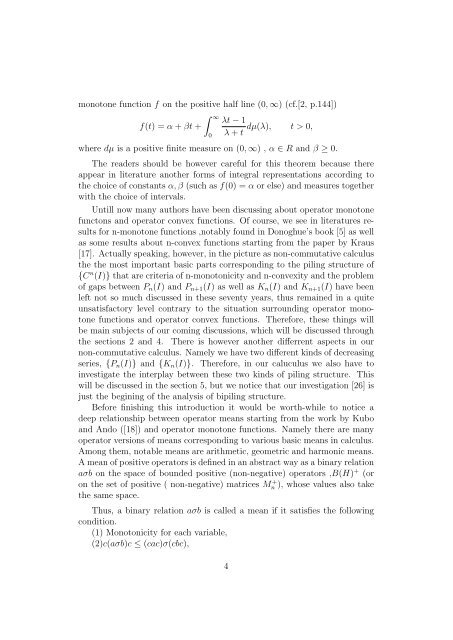Recent development of the theory of matrix monotone functions and ...
Recent development of the theory of matrix monotone functions and ...
Recent development of the theory of matrix monotone functions and ...
- No tags were found...
Create successful ePaper yourself
Turn your PDF publications into a flip-book with our unique Google optimized e-Paper software.
<strong>monotone</strong> function f on <strong>the</strong> positive half line (0, ∞) (cf.[2, p.144])f(t) = α + βt +∫ ∞0λt − 1dµ(λ), t > 0,λ + twhere dµ is a positive finite measure on (0, ∞) , α ∈ R <strong>and</strong> β ≥ 0.The readers should be however careful for this <strong>the</strong>orem because <strong>the</strong>reappear in literature ano<strong>the</strong>r forms <strong>of</strong> integral representations according to<strong>the</strong> choice <strong>of</strong> constants α, β (such as f(0) = α or else) <strong>and</strong> measures toge<strong>the</strong>rwith <strong>the</strong> choice <strong>of</strong> intervals.Untill now many authors have been discussing about operator <strong>monotone</strong>functons <strong>and</strong> operator convex <strong>functions</strong>. Of course, we see in literatures resultsfor n-<strong>monotone</strong> <strong>functions</strong> ,notably found in Donoghue’s book [5] as wellas some results about n-convex <strong>functions</strong> starting from <strong>the</strong> paper by Kraus[17]. Actually speaking, however, in <strong>the</strong> picture as non-commutative calculus<strong>the</strong> <strong>the</strong> most important basic parts corresponding to <strong>the</strong> piling structure <strong>of</strong>{C n (I)} that are criteria <strong>of</strong> n-monotonicity <strong>and</strong> n-convexity <strong>and</strong> <strong>the</strong> problem<strong>of</strong> gaps between P n (I) <strong>and</strong> P n+1 (I) as well as K n (I) <strong>and</strong> K n+1 (I) have beenleft not so much discussed in <strong>the</strong>se seventy years, thus remained in a quiteunsatisfactory level contrary to <strong>the</strong> situation surrounding operator <strong>monotone</strong><strong>functions</strong> <strong>and</strong> operator convex <strong>functions</strong>. Therefore, <strong>the</strong>se things willbe main subjects <strong>of</strong> our coming discussions, which will be discussed through<strong>the</strong> sections 2 <strong>and</strong> 4. There is however ano<strong>the</strong>r differrent aspects in ournon-commutative calculus. Namely we have two different kinds <strong>of</strong> decreasingseries, {P n (I)} <strong>and</strong> {K n (I)}. Therefore, in our caluculus we also have toinvestigate <strong>the</strong> interplay between <strong>the</strong>se two kinds <strong>of</strong> piling structure. Thiswill be discussed in <strong>the</strong> section 5, but we notice that our investigation [26] isjust <strong>the</strong> begining <strong>of</strong> <strong>the</strong> analysis <strong>of</strong> bipiling structure.Before finishing this introduction it would be worth-while to notice adeep relationship between operator means starting from <strong>the</strong> work by Kubo<strong>and</strong> Ando ([18]) <strong>and</strong> operator <strong>monotone</strong> <strong>functions</strong>. Namely <strong>the</strong>re are manyoperator versions <strong>of</strong> means corresponding to various basic means in calculus.Among <strong>the</strong>m, notable means are arithmetic, geometric <strong>and</strong> harmonic means.A mean <strong>of</strong> positive operators is defined in an abstract way as a binary relationaσb on <strong>the</strong> space <strong>of</strong> bounded positive (non-negative) operators ,B(H) + (oron <strong>the</strong> set <strong>of</strong> positive ( non-negative) matrices M n + ), whose values also take<strong>the</strong> same space.Thus, a binary relation aσb is called a mean if it satisfies <strong>the</strong> followingcondition.(1) Monotonicity for each variable,(2)c(aσb)c ≤ (cac)σ(cbc),4













